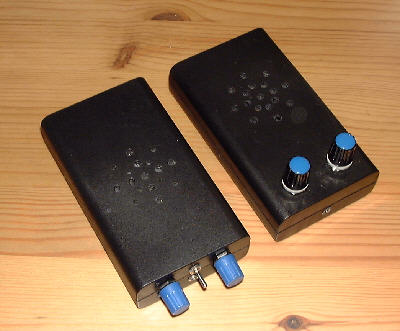Bat detector
Bat detectors allow the observation of bats without disturbing them.
Commercial off-the-shelf detectors are as a rule very expensive because of
a low demand, but it is possible to build bat detecors yourself.
There are three different styles of detection:
- Heterodyning detectors - a frequency can be adjusted and is combined with
an internal oszillator, thus producing an audible result
- Divider - a wide range of frequencies is scanned by dividing all
frequencies to audible sound
- Slower replay - Ultrasonics are recorded digitally and replayed
more slowly
Detectors may be built relatively easily for the first two systems.
Dividers have the advantege that bats will be detected over a wide range of
frequencies even if their call frequency is not known. The result, however, is a course clicking
sound and distinguishing species is not possible this way.
Heterodyning detectors monitor only a small chosen range of frequencies
but retain the feel of the call, enabeling one with some
practise to distinguish species by frequency and sound characteristics with some accuracy
(at least where we live, with only 5 species frequent of around a dozend which may
occur in the vicinity). In addition to the call, the flight patterns, size,
surrounding habitat, and behaviour of the bat should be taken into account
when trying to put a name to the species.
|
After a period of experimentation since 1995, I have developed a
heterodyning bat detector, which fits into a small casing and even has
a built-in speaker. The photo shows two different constructions.
The detector is not quite a beginners kit, so if you are
interested in a receiver, then contact me via
e-Mail - from time to
time I may have some spare detectors.
|
|
|
|
This picture shows the construction of the
bat detector. The PCB to the front of the case, loudspeaker
installed in the lid needs the room in the middle of the case
and battery to the rear. There is also a headphone jack.
I also recommend
Tony Messinas Homepage.
Tony presents a divider detector he has developed.
|
May 20th: After a workshop last week I have two surplus bat detectors, 50 Euro each.
back to main page

